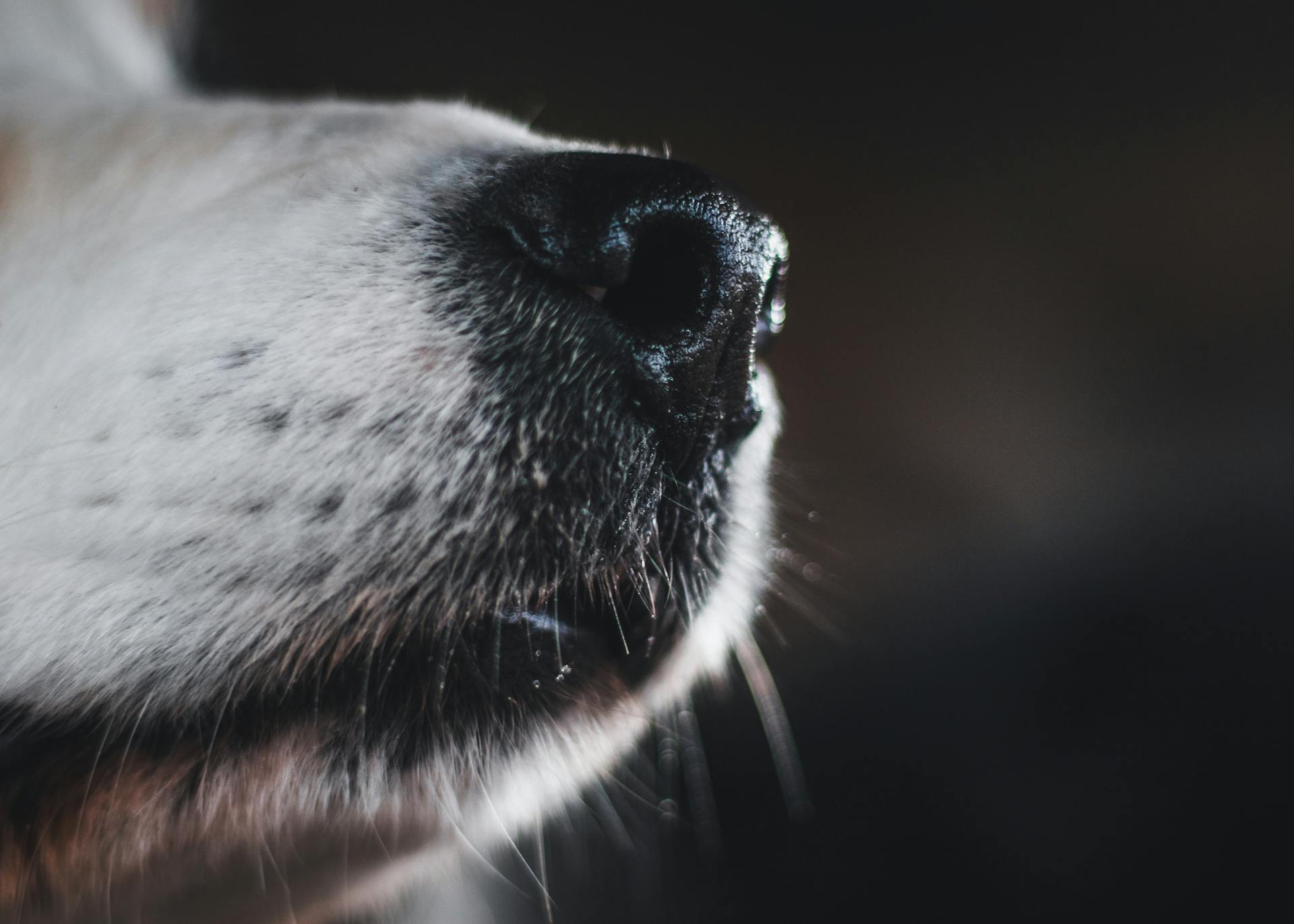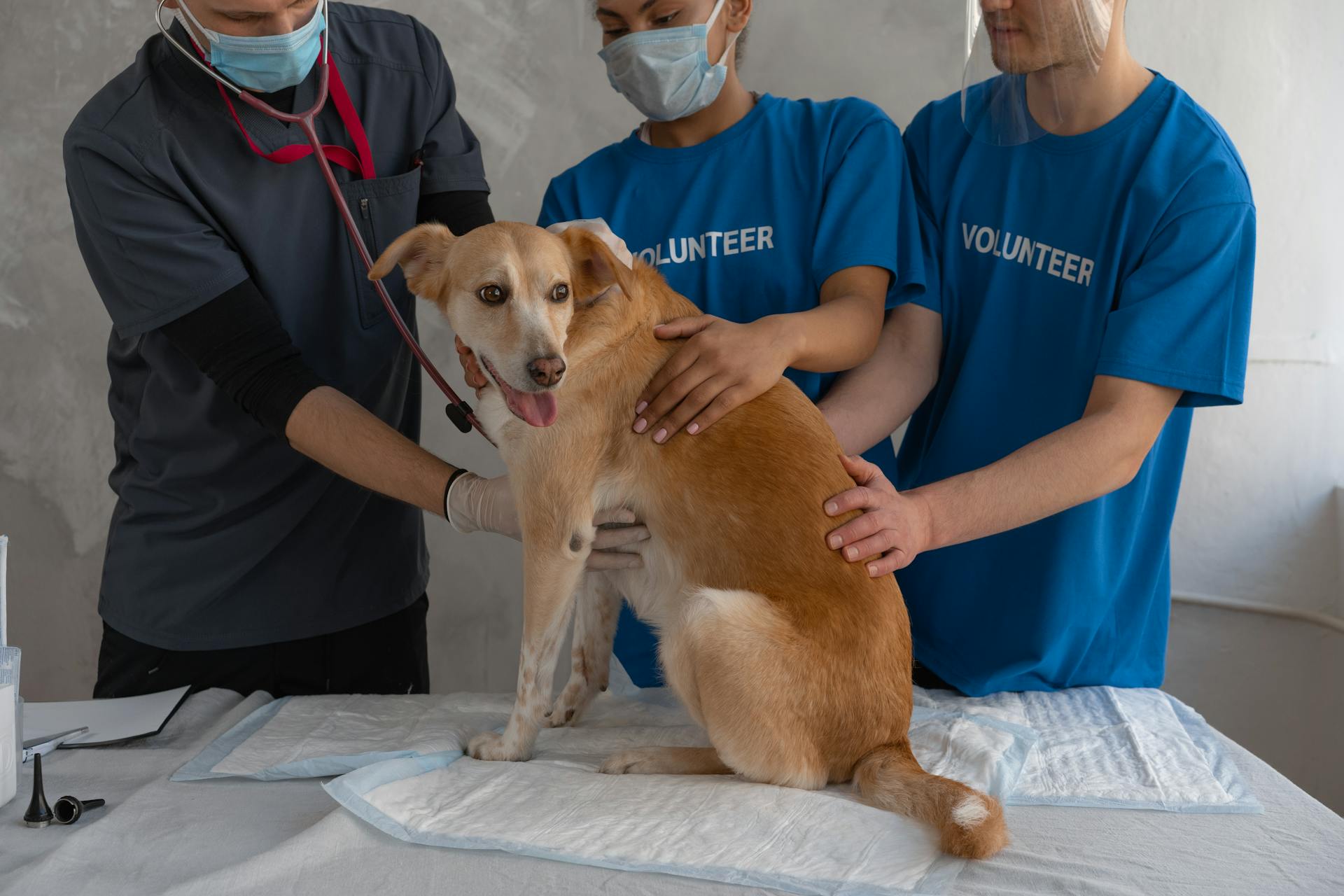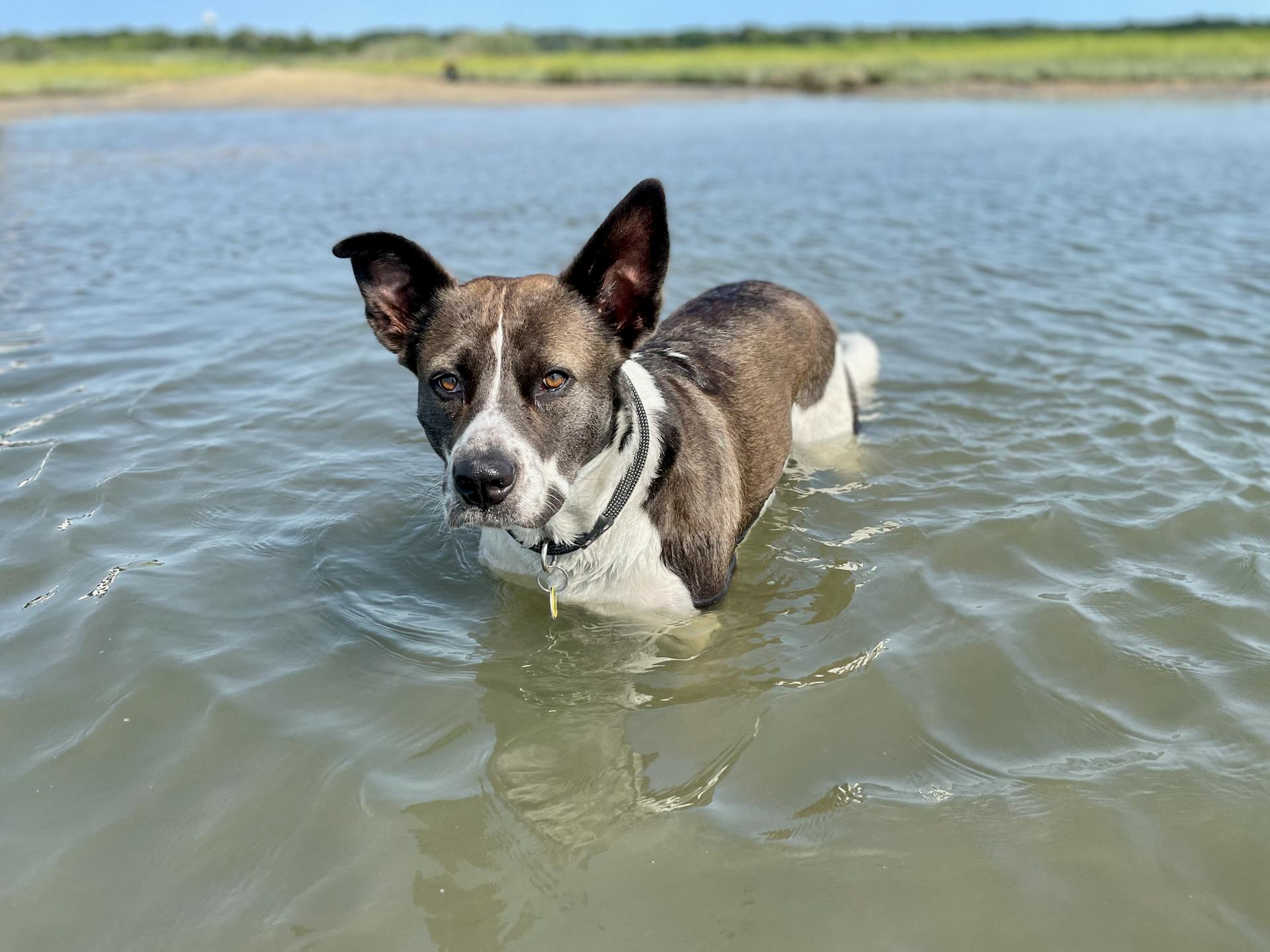
Canine influenza, also known as dog flu, is a contagious respiratory disease caused by the H3N8 or H3N2 viruses.
The H3N8 virus was first detected in 2004 in the United States. It has since become a common cause of canine influenza outbreaks, particularly in areas with large dog populations.
Kennel cough, on the other hand, is a common term for a contagious cough caused by the Bordetella bronchiseptica bacteria.
Symptoms of canine influenza can include fever, cough, and runny eyes, while kennel cough typically presents with a persistent, hacking cough.
Readers also liked: Is Kennel Cough Contagious after Antibiotics
What Is
Canine influenza, commonly referred to as dog flu, is a contagious upper respiratory infection in dogs caused by the canine influenza virus.
It's not a seasonal illness, unlike human influenza, and can be contracted by dogs at any point in the year.
Consider reading: Can Older Dogs Get Kennel Cough
Causes and Transmission
Canine influenza is caused by two strains of viruses: CIV H3N8 and H3N2. These viruses are highly contagious and can spread quickly because most dogs have no immunity against them unless they are vaccinated.
Dogs can contract canine influenza from being in close contact with other dogs, through shared food bowls and toys, and airborne droplets through sneezing, coughing, and barking. Any setting that brings dogs close together, especially indoor settings, increases the risk of spreading canine influenza.
The virus can survive for one to two days in the environment but is easily killed by common disinfectants. Infected dogs can be contagious even if they don't seem ill, and they can spread the virus for up to four weeks after they were first exposed to it.
Here are the common routes of exposure to canine influenza:
- Direct contact, as when dogs lick or nuzzle each other
- Coughing, sneezing, and barking
- Contaminated objects like food and water bowls, toys, kennel surfaces, or clothing
- Skin and clothing of people who have been in contact with infected dogs
What Causes?
Two strains of viruses can cause the canine flu: CIV H3N8 and H3N2.
These viruses are highly contagious and can spread quickly because most dogs have no immunity against them unless they are vaccinated.
Dogs can contract canine influenza from being in close contact with other dogs, like in kennels.
Suggestion: Can My Dog Get Kennel Cough Again

Shared food bowls and toys are also common ways for dogs to catch the virus.
Airborne droplets from sneezing, coughing, and barking can spread the virus too.
All breeds and ages of dogs are susceptible to catching the virus.
Almost all dogs who are exposed to the virus will catch it.
A fresh viewpoint: Can Dogs Get Kennel Cough after Bordetella Shot
Spread
Canine influenza is a highly contagious virus that can spread quickly among dogs. Two strains of the virus, CIV H3N8 and H3N2, can cause the disease.
Most dogs have no immunity against the virus unless they are vaccinated. This means that even healthy dogs can catch the virus if they're exposed to it.
The virus can spread through respiratory droplets, direct contact, and contaminated objects. Dogs can contract the virus by licking or nuzzling each other, as well as through coughing, sneezing, and barking.
Infected dogs can be contagious even if they don't seem ill, and they can spread the virus for up to four weeks after they were first exposed to it.
A unique perspective: How Is Kennel Cough Spread
The virus can survive on skin and hands for 12 hours, on clothing for 24 hours, and surfaces for up to 48 hours. This means that dogs can pick up the virus from contaminated objects or people who have been in contact with infected dogs.
Here are some high-risk settings where the virus can spread:
- Dog daycare
- Dog parks
- Dog shows
- Agility events
- Boarding facilities
It's also worth noting that cats can contract the influenza virus from dogs and humans, so it's best to keep them inside to prevent spreading the flu to other cats or dogs.
Explore further: Can Cats Catch Kennel Cough
Symptoms and Conditions
Canine influenza and kennel cough can be tricky to diagnose, but there are some key symptoms to look out for.
Fever, cough, sneezing, lethargy, and green or yellow discharge around the nose and eyes are all common signs of canine influenza.
Some dogs may also exhibit laboured breathing, decreased appetite, and a persistent cough that lasts for at least a week.
Suggestion: Canine Influenza
Kennel cough, on the other hand, is often caused by the highly contagious bacteria bordetella bronchiseptica and can be confused with canine influenza due to similar symptoms.
Infected dogs will typically develop symptoms within 2-4 days following exposure, and the common clinical signs include coughing, mild to high-grade fevers, nasal and ocular discharge, and decreased activity.
Here are some common symptoms of canine influenza and kennel cough:
- Persistent cough
- Thick nasal discharge
- Fever (often 104-105F)
- Lethargy
- Runny eyes
- Reduced appetite
It's worth noting that some dogs may not show any symptoms at all, while others may develop complications such as bacterial pneumonia, resulting in more severe illness.
Diagnosis and Treatment
Diagnosis of canine influenza requires specific laboratory tests due to its similarities to other respiratory infections. Your veterinarian may suspect canine influenza based on your dog's history and lifestyle, and laboratory tests such as nasal or pharyngeal swabs or blood samples can confirm the diagnosis.
Early sampling greatly increases the chance of capturing the viruses during their peak shedding period, so it's essential to collect a nasal swab on day 1 or 2 of the onset of symptoms. This sample should be sent in a sterile tube of viral transport media and shipped overnight to maximize the probability of a positive PCR result.
For your interest: Nasal Discharge Kennel Cough
Treatment for canine influenza is largely supportive, designed to provide rest, fluids, and nutritional care and keep the dog comfortable. Most dogs fully recover from canine influenza within two to three weeks, but dogs exposed to the virus should be isolated for four weeks to prevent further spread, even if they do not develop any respiratory signs.
Is Diagnosed
Diagnosing canine influenza can be tricky because the symptoms are similar to other respiratory infections. Your vet will need to conduct tests to detect and identify the virus.
The first step is to take a nasal swab for a polymerase chain reaction (PCR) test, which can be submitted to a veterinary laboratory. This test is most accurate within the first few days of illness.
If the PCR test is positive, it's likely that your dog has canine influenza virus. However, after four days of illness, PCR results may be less accurate and may even produce false-negative results.
Related reading: Is There a Test for Kennel Cough
Your vet may also recommend blood testing for CIV antibodies, which involves comparing antibody levels two to three weeks apart. If antibody levels rise significantly over this period, it indicates active CIV infection.
To maximize the chances of a positive PCR result, the swab should be taken on day 1 or 2 of the onset of symptoms, and the sample should be sent in a sterile tube of viral transport media and shipped overnight.
What Is the Treatment?
The treatment for canine influenza is largely supportive, designed to provide rest, fluids, and nutritional care to keep your dog comfortable.
Dogs with canine influenza need to be kept isolated from other dogs to prevent the disease from spreading, with a recommended isolation period of four weeks after signs first appeared.
In severe cases, your vet may recommend antibiotics to clear a secondary bacterial infection, which can cause symptoms like a thick green mucous discharge from the nose.
Some dogs may need to be hospitalized for nutritional support, such as a feeding tube or intravenous fluids, if they haven't been eating or drinking.
Most dogs fully recover from canine influenza within two to three weeks, but it's essential to consult with your veterinarian to determine the best course of treatment.
Good nutrition and husbandry are crucial in ensuring that dogs mount an adequate immune response to help promote faster recovery, so a high-quality diet is recommended.
Dogs that develop pneumonia may require hospitalization, intravenous fluids, and medications, as well as potent broad-spectrum antibiotics.
Prevention and Care
Vaccinating your dog is one of the best ways to prevent canine influenza. Speak with your vet about vaccine options during regular bordetella vaccination visits.
To prevent the spread of the virus, wash your hands thoroughly after petting or playing with other dogs. This is especially important if you suspect your dog may have been exposed to the virus.
If your dog displays flu-like symptoms, keep them isolated from other dogs until they are symptom-free. This will help prevent the spread of the virus to other dogs.
Most dogs recover from canine influenza virus fully if they receive good care and medical attention as required. If you suspect your dog has canine influenza, take them to the vet right away.
The CIV vaccine cannot completely prevent the disease, but it may reduce the severity and duration of clinical signs associated with infection. This is especially important in at-risk dogs and helps reduce the spread of outbreaks.
Here are some key takeaways to keep in mind when it comes to preventing and caring for your dog with canine influenza:
- Vaccinate your dog against canine influenza
- Wash your hands thoroughly after interacting with other dogs
- Isolate your dog if they display flu-like symptoms
- Provide good care and medical attention as required
Note: The CIV vaccine is not a guarantee against infection, but it can help reduce the severity and duration of symptoms.
Frequently Asked Questions
Is canine influenza the same as Bordetella?
No, canine influenza is not the same as Bordetella, which is a different contagious respiratory disease that affects dogs. Consult with your veterinarian to understand the differences and determine the best vaccination plan for your dog.
Is canine parainfluenza the same as kennel cough?
Canine parainfluenza is a key component of kennel cough, a contagious respiratory disease complex that affects dogs. Kennel cough is not a single disease, but rather a complex of diseases caused by various viruses and bacteria, including parainfluenza.
What is the canine influenza also known as?
Canine influenza is also commonly known as dog flu. It's a contagious respiratory disease that affects dogs.
Sources
- https://www.trudellanimalhealth.com/learn/further-reading/dog-flu-signs-symptoms-treatments
- https://www.avma.org/resources-tools/pet-owners/petcare/canine-influenza
- https://vcahospitals.com/know-your-pet/canine-influenza-the-dog-flu
- https://www.ksvdl.org/resources/news/diagnostic_insights/april2016/Influenza.html
- https://www.nj.gov/agriculture/divisions/ah/diseases/canineflu.html
Featured Images: pexels.com


